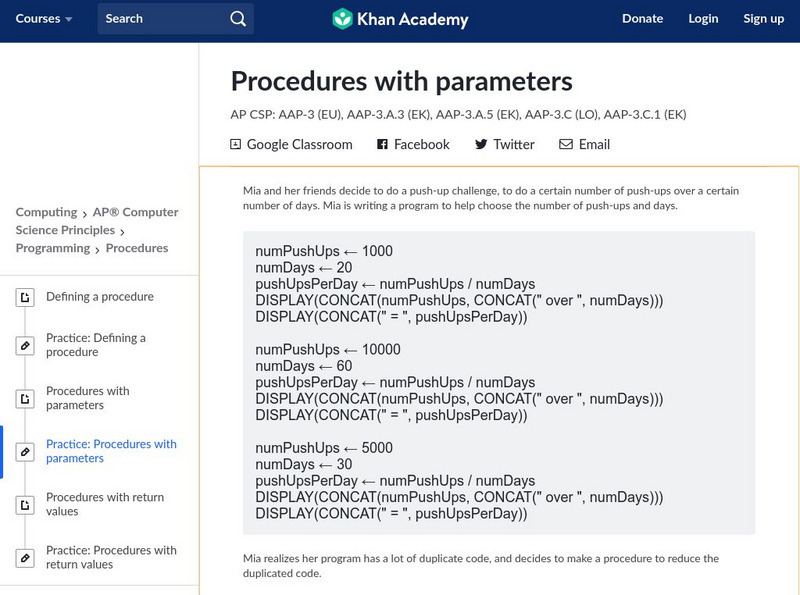Khan Academy
Khan Academy: What Are the Parts of a Computer?
Each computer receives input from a variety of devices, processes that data with the CPU and memory, and sends results to some form of output. This diagram visualizes that flow.
Khan Academy
Khan Academy: Iterating Over Lists With Loops
Practice using loops to iterate through lists in programs written in the AP CSP pseudocode.
Khan Academy
Khan Academy: What Is a Computer File?
Learn about some of the different computer file types.
Khan Academy
Khan Academy: Secondary Memory
Types of long term storage of data on the computer and retrieval are examined.
Khan Academy
Khan Academy: Storing Data in Variables
Find out how computer programs instruct computers how to process data.
Khan Academy
Khan Academy: Mathematical Expressions
A computer can compute results for them in a fraction of a second. Find out how we actually get the computer to do math for us?
Khan Academy
Khan Academy: File Types
Computers store all files as binary data, long strings of 111s and 000s. Files represent all types of data: images, videos, documents, text files, spreadsheets, and applications. Files are stored as binary data.
Khan Academy
Khan Academy: File Sizes
Small and large computer file sizes are examined with examples of storage data.
Khan Academy
Khan Academy: Input & Output Devices
Computer input and output devices are examined in this article.
Khan Academy
Khan Academy: Number Limits, Overflow, and Roundoff
Learn about the limitations of storing numbers in computer programming.
Khan Academy
Khan Academy: Random Numbers
See how we can generate random values in our computer programs, and use those to make decisions and simulate natural processes.
Khan Academy
Khan Academy: String Operations
Computer programs don't just store strings, they also manipulate them. With string operations, we can chop strings up, mash strings together, or transform strings in all sorts of ways. Learn how here.
Khan Academy
Khan Academy: Hexadecimal Numbers
The Hexadecimal number is explained as well as its relationship and need in computers.
Khan Academy
Khan Academy: Computer Malware
Learn about malware, how it is installed on a computer, and what type of damage it can do.
Khan Academy
Khan Academy: Computer Networks
Learn about the internet, the world's largest computer network.
Khan Academy
Khan Academy: Numbered Repetition of Instructions
Computer programs are full of repetition, since our programs automate and simulate the world around us. Programmers use for loops to repeat a set of instructions a specific number of times.
Khan Academy
Khan Academy: Undecidable Problems
Problems a computer can never solve are called "undecidable problems". No algorithm exist that can answer the problem on all inputs.
Khan Academy
Khan Academy: Public Key Encryption
Public Key Encryption, an asymmetric encryption technique, is used to allow computers to securely communicate. The high level process is explained in this article.
Khan Academy
Khan Academy: Procedures With Parameters
Practice using procedures with parameters for computer programming.
Khan Academy
Khan Academy: Public Key Encryption
Learn how public key encryption can protect computer data.























